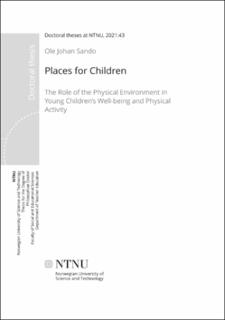| dc.contributor.advisor | Ellen Beate Hansen, Ingar Mehus | |
| dc.contributor.author | Sando, Ole Johan | |
| dc.date.accessioned | 2021-02-15T12:11:13Z | |
| dc.date.available | 2021-02-15T12:11:13Z | |
| dc.date.issued | 2021 | |
| dc.identifier.isbn | 978-82-326-6167-1 | |
| dc.identifier.issn | 2703-8084 | |
| dc.identifier.uri | https://hdl.handle.net/11250/2728090 | |
| dc.description.abstract | Early Childhood Education and Care (ECEC) institutions are essential for children’s everyday experiences, health and development. The physical environment represents a crucial part of the learning environment in ECEC institutions, which is scarcely explored in research. This study explores how the physical environment in ECEC institutions influences children’s well-being and physical activity, two fundamental health indicators in childhood.
The influence of the physical environment on children’s well-being and physical activity was investigated by observing children’s interactions with the physical environment during periods of free play in the indoor and outdoor environments of eight ECEC institutions in Norway. The total sample in this study consisted of 1808 video observations of 80 children at two data points. The observations were analysed with both qualitative and quantitative approaches. Measures of well-being, physical activity, the physical environment, play and the social context were included in the study.
The physical ECEC environment was found to be closely related to children’s physical activity. In the outdoor environment, pathways and open areas were identified as places that were positively associated with physical activity. Mixed results were found for the association between fixed equipment for functional play and physical activity. Using materials in the outdoor environment was, for the most part, found to be negatively associated with children’s physical activity. In the indoor environment, physical activity was positively associated with environments for physical activity, cubbies and open floor spaces and negatively associated with using tables. The results in this study suggest that children’s physical activity is influenced by the physical environment through the affordances for movement and play in the environment.
Children’s well-being was found to be more weakly associated with the physical ECEC environment compared to their physical activity. Natural environments and open spaces in the outdoor environment were positively associated with well-being. Indoor environments for physical activity were found to be positively related to well-being, whereas using tables was negatively associated with well-being. The findings in this study indicate that the physical environment influences children’s well-being through the experiences and feelings it provides, the play possibilities afforded, the opportunities to be physically active, and the mastery of physical challenges.
The findings in this study demonstrate that the physical environment of ECEC institutions is important for children’s well-being and physical activity. Moreover, play was found to be strongly associated with both well-being and physical activity, and the physical environment influenced children’s play behaviour. A physical ECEC environment of high quality provides children with meaningful and varied play opportunities that benefit children’s everyday experiences and their health. | |
| dc.language.iso | eng | en_US |
| dc.publisher | NTNU | en_US |
| dc.relation.ispartofseries | Doctoral theses at NTNU;2021:43 | |
| dc.relation.haspart | Paper 1: Sando, Ole Johan. The outdoor environment and children’s health: a multilevel approach. International Journal of Play 2019 ;Volum 8.(1) s. 39-52
https://doi.org/10.1080/21594937.2019.1580336
This is an Open Access article distributed under the terms of the Creative Commons Attribution License (CC BY 4.0) (http://creativecommons.org/
licenses/by/4.0/), | en_US |
| dc.relation.haspart | Paper 2: Sando, Ole Johan. The physical indoor environment in ECEC settings: children’s well-being and physical activity. European Early Childhood Education Research Journal 2019 ;Volum 27.(4) s. 506-519
https://doi.org/10.1080/1350293X.2019.1634238
This is an Open Access article distributed under the terms of the Creative Commons Attribution License (CC BY 4.0) (http://creativecommons.org/
licenses/by/4.0/), | en_US |
| dc.relation.haspart | Paper 3: Sando, Ole Johan; Mehus, Ingar. Supportive indoor environments for functional play in ECEC institutions: a strategy for promoting well-being and physical activity?. Early Child Development and Care 2019 s. 1-13
https://doi.org/10.1080/03004430.2019.1651305
This is an Open Access article distributed under the terms of the Creative Commons Attribution License (CC BY 4.0) (http://creativecommons.org/
licenses/by/4.0/), | en_US |
| dc.relation.haspart | Paper 4: Sando, Ole Johan; Hansen Sandseter, Ellen Beate. Affordances for physical activity and well-being in the ECEC outdoor environment. Journal of Environmental Psychology 2020 ;Volum 69.
https://doi.org/10.1016/j.jenvp.2020.101430
This is an open access article under the CC BY license
(http://creativecommons.org/licenses/BY/4.0/). | en_US |
| dc.title | Places for Children: The Role of the Physical Environment in Young Children’s Well-being and Physical Activity | en_US |
| dc.type | Doctoral thesis | en_US |
